
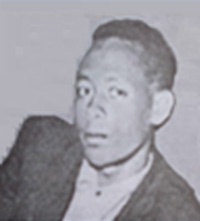

“either I shall dismantle Haile Selassie’s regime or I shall die on the way"



Compiled and researched by Resoum Kidane
Introduction
Although a number of African countries gained their independence in the 1960s, the struggle for decolonisation didn’t cease. In fact the fight for independence, political and civil rights intensified. An example is the Eritrean people waging armed struggle for independence, following Emperor Haile Selassie unilaterally abolishing Eritrea’s federal status in 1962.
To protest against state oppression and violation of political and civil rights, several passenger planes were hijacked the members of liberations movements or their affiliated student movement organisations to publicise their cause. Using hijacks as a political weapon became a new method in revolutionary struggle in the late 1960s and early 1970s. According to (Paul Wilkinson (2001), in 1969, there were 82 recorded hijack attempts worldwide more than twice the total attempts for the period 1947-67.
In a book "The battle of Eritrea", in Arabic, translated from Osman Denden’s book, the following members of the ELF were mentioned as hijacking Ethiopia Boeing passengers plane in 1969 and 1971: Ali Said Abdella who destroyed an Ethiopian Airline Boeing 720 at Karachi Airport in 1969; Mohamed Osman Yusuf Saig and Mohamed Ali Omar Afarorah who hijacked an Ethiopian passenger plane, a Boeing 707, in March 1969; Mohamed Saeed Salih Sengour etc. who hijacked an Ethiopian Airline plane in September 1969; Ali Mohamed Omer, Hamid Shateen , Mahmoud Suleiman who hijacked Ethiopian Airline plane, Boeing 720 in November 1969 and Afworki Mengistu, the pilot who highjacked an Ethiopian military plane and was made to land at a military airport in northern Somalia, in November 1971. However, Amanuel Yohannes' name is not mentioned by the author in the book.
Amanuel Yohannes was one of those hijackers who was involved twice in plane hijacking with members of the EPLF and EPRP in 1971 and 1972. The aim of both operations was to protest the Ethiopian people oppression by the Haile Selassie’s regime and its illegal abolishing of the Eritrea-Ethiopia federation.
In the beginning Amnauel hijacked a domestic plane with Yohannes Sebhatu, Debesai Gebre Selassie and Musie Tesfamichael 1971 and joined the EPLF. Thereafter he was sent for a second operation to Addis Ababa but the second hijack operation attempt did not succeed. He was killed, on the 8th December 1972, with six fellow hijackers, affiliated with the EPRP, by the Ethiopian security .
Sadly, Amanuel Yohannes and his comrades were forgotten by both Fronts during the liberation struggle and by the PFDJ after Eritrea achieved independence. The likely explanation for this is that Yohannes Sebhatu, Debesai Gebre Selassie and Musie Tesfamichael who hijacked the domestic plane with Amnauel were executed under the pretext of their participation in Menkae. The EPLF, therefore, didn’t want to honour them. The ELF (Jebha), for their part, only honour Eritrean hijackers who were affiliated with the ELF not EPLF members, like Amanuel Yohannes
Since 1972, the story of Martha Mebrahtu, Wallelign Mekonnen, Berhane Meskel have been repeatedly publicised but not that of Amanuel. He was well known for his international and revolutionary outlook by most former members of the University Students Union of Addis Ababa (USUAA ). Despite this, Amanuel’s story has not been told by the former USUAA members or other Ethiopian writers.
This raises a question: why is the story of Amanuel Yohannes contributions to the Eritrea and Ethiopia revolutions forgotten by all of the above?
The purpose of this compilation is to provide brief background information about the forgotten hero Amanuel Yohannes, a selfless and gallant patriot who never hesitated to sacrifice his life. It is also to honour him with his comrades Yohannes Sebhatu, Debesai Gebre Selassie and Musie Tesfamichael who all became victim of the EPLF leaders.
Amanuel and his comrades should be remembered by the present and future younger generations for the significant role they played, in the early 1970s,.in the struggle for independence.
Personal background information
Amanuel Yohannes was born in 1946 in Keren, and brought up in a humble and respectable Catholic family environment. He was described by his close friend, Emnetu Tesfai, as a robust and intelligent young man with a stentorian voice (nicknamed Radio) and captivating humility who possessed a charming personality and smile. Most importantly, he's an Eritrean whose honesty and integrity could easily be read in his face.
Ammanuel Gebre Yesus, who hijacked an Ethiopian plane on a domestic flight with Berhane Meskel Redd in 1969, describes Amanuel Yohannes as a humble and innocent person: ‘we called him “The Saint”’. Tesfamicael T.Ogbu one of Amanuel’s relative who last met him in 1965 also describes Amanuel as a “saint”.
Amanuel spent his childhood at Kidane-Mihret Shuk, in Asmara. and was one of the first generation of students from post-Italian colonialism who received his education following the development of modern education from 1942. After completing his middle school education he attended the General Wingate Secondary School from 1961 to1964 in Addis Ababa. After graduation, in 1965, he was accepted to the Haile Selassie 1 University (HSIU) to study Economics where his political consciousness was influenced by:
His early political awareness could also be strongly influenced by the sporadic student strikes, trade union strike and professional association demonstrations in protesting against the violation of civil and political rights during the Federation period. To mention but a few: the student strikes occurred at the Haile Selassie Secondary School in Asmara where Amharic was made compulsory in 1957; students’ demonstration opposing the removal of the Eritrean flag in September 1960; and the brutal crushing of the general strike in Asmara, 1958.
All the above contributed significantly to Amanuel becoming a dedicated Marxist and against Haile Selassie’s regime. For that reason, Amanuel’s motto became: “either I shall dismantle Haile Selassie’s regime or I shall die on the way”.
It should be also mentioned that Amanuel played a key role to advance solidarity within the progressive Eritrean and Ethiopian students during his studies at the Haile Selassie 1University (HSIU). Emnetu in his memory of Amanuel Yohannes state that when socialist revolutionary ideas were introduced in to the university there was a debate on who are the enemies and the friends of the Eritrean people? The argument that the enemy of the Eritrean people was not the Ethiopian people but the ruling class was supported by students like Amnauel who believed that the unity of the Eritrean and Ethiopian peoples’ struggle would lead to the ultimate victory of the oppressed people and to the defeat of the ruling class.
The compiler of this document recalls that, in 1975, the EPLF taught their fighters: "The enemy of the Eritrean people are Imperialists, Zionists and the Ethiopian ruling class not Ethiopia’s oppressed people". However, later the EPLF changed its political narrative to one that declared that the EPLF was fighting against the repressive regime in Ethiopia, and not the people of Ethiopia, who were oppressed themselves. This might have been around the time that the Ethiopian revolution was hijacked by the Military Junta. It was also when the Ethiopian Students' Union in North America (ESUNA) argued that the Eritrea question was not a colonial question which was published in ESUNA’S combat VOL. No. 2 October 1976.
Amanuel was always described by his friends as one of the progressive students and took his place in the ranks of the student union, by fighting in an internationalist spirit against oppression. To achieve his revolutionary socialist vision and the victory of the Eritrean and Ethiopian oppressed people against the feudal systems in Ethiopia, Amanuel continued working hard to strengthen the unity of the progressive students from the following institutions: Arts Faculty at the Sidist Kilo University Campus, Science Faculty at Arat Kilo and Medical School at Ledeta where Martha Mebrhatu studied who was a seventh year Medical student. She was killed with Amanuel and six of her colleagues who tried to hijack an Ethiopian Airlines commercial on 8th December 1972.
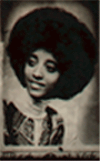
Inquay do anes (let alone I)
Marta qua meyta ab
(even Martha perished in the sky)
Martha was another conscious and mature progressive student who had a desire to serve her people. Martha Mebrahtu (her peers affectionately called her the Angela Davis of Ethiopia) strongly believed in uniting solidarity between progressive Eritrean and Ethiopian and she wrote (roughly translated from Amharic):
“We, women of Ethiopia and Eritrea, have made ourselves ready to participate in a struggle, and we would like to explain the nature of our struggle to our sisters and brothers all over the world.
Our struggle demands a bitter sacrifice in order to liberate our oppressed and exploited people from the yokes of feudalism and imperialism. In this struggle we have to be bold and merciless. Our enemies can only understand such a language.
We, women of Ethiopia and Eritrea, are not only exploited as members of the working classes and peasants, we are also victims of gender inequality, treated as second class citizens. Therefore, our participation in this struggle must redouble the efforts of other oppressed groups; we must fight harder, we must be at the forefront.
We must equally participate in the struggle for economic and social justice that our brothers have waged. We have a responsibility to become a formidable force in the revolutionary army.”
(Excerpt from Elyas Mulu Kiros Nov 23, 2011)
Regarding the formation of solidarity by progressive Eritreans and Ethiopians at HSIU in the 1960s and early 1970s, Amanuel Gebre Yesus, also said that in those student movements of that time, we were not narrow nationalists and we were not negative about the Eritrean cause but we strived for a greater Africa to live peacefully together. We wanted a broader revolution against feudalism in Ethiopia. Our emphasis was on the social situation in the country and we wanted change to achieve democracy, justice, liberty and self-determination. Walelege Mekonen, who was killed with Amnuel in hijacking a plane on 8th December 1972, he also encouraged Eritreans to come out in the open and talk about the struggle raging in Eritrea
Petros Tesfa Giorgis another progressive student at that time states the student movement brought Ethiopian and Eritrean students in collective activity in search of a solution to the misery of the people of Ethiopia and to end the brutal war in Eritrea. He adds that the Eritrean university students saw a light at the end of the tunnel and became very active in the Ethiopian students’ movement. Thus the Addis Ababa University became the melting pot of revolutionaries. It brought together students from different nationalities
By and large in late 1960s and early 1970s those progressive Eritrean and Ethiopian students like Amanuel Yohannes, Petros Yohannes, Temesgen Haile, Wallelign Mekonnen etc. were inspired by the teachings of Marx and Lenin and started to see in socialist ideology as a way out of poverty and oppression.
Emnetu Tesfai wrote in memory of Amnauel Yohannes written in Geez script, in Tigrinya language,
ዝኽርታተይ ብዛዕባ ጅግና ተጋዳላይ ኣማኑኤል ዮውሃንስ
ሃገርና ኤርትራ ብነጻነታ ንኽትኰርዕ ፥ ህዝቢ ኤርትራ’ውን ብፍትሕን ብሓርነትን ንኽነብር ክብሉ ፥ በብዝተፈላለየ መልክዓ-ፍጻሜታቱ ከቢድ ዋጋ ዝኸፈሉ ዓበይትን ንእሽቱን ኤርትራውያን ኣዝዮም-ኣዝዮም ብዙሓት’ዮም። ኣብ ርእሲ’ቶም ብጅግነንት ኣብቲ መሪር ናይ 30 ዓመታት ብረታዊ ቃልሲ ዝተሰውኡን ዝሰንከሉን ፥ ኣስማቶም ገና ዘይተገልጸ ብዙሓት ሓርበኛታት ኤርትራውያን’ውን ፥ ኣብ ውሽጢ’ቲ ከርሲ ናይቲ ሽዑ ዝነበረ ገዛኢ-ስርዓት ኢትዮጵያ ብምእታው ፥ መስተንክር ዝዀነ ገድላዊ ስርሓት ፈጺሞም ዝሓለፉ ጀጋኑና ኤርትራውያን ኔሮም’ዮም። ነዞም ጀጋኑ ኤርትራውያን እምበኣር ፥ ስሞም እንዳዘከርና ብኣኣቶም ክንሕበንን ክንኰርዕን ግቡእ’ዩ። ዋላ’ኳ ነቲ ዝኸፈልዎ ክቡር ናይ ህይወት ዋጋ ክንመልሶ እንተ ዘይክኣልና’ውን ፥ ጅግንነቶም ብግቡእ ሰኒድና ህያዋን ሓወልቲ ክንገብሮም ዓቢይ ሓላፍነት’ዩ ዘሎና።
ሓደ ካብኣቶም ፡ እቲ ግሩም ቁመና ዝነበሮ ጅግና ተጋዳላይ ኣማኑኤል ዮውሃንስ’ዩ። እቶም ብቐረባ ንፈልጦ ዝነበርና ፥ በሊሕ ኣእምሮ ዚውንን ፥ ብትሕትንኡ ምስጉን ፡ ብስነ-ምግባር ተዀስኲሱ ዝዓበየ ሰብ ከም ዝነበረ’ዩ።
እቲ ኣብ መጀመርታ ጊዜ ክላለዮ ዝኽኣልኩ ፥ ኣብቲ ካብ 1961 ክሳብ 1964 ዓ. ም. ኣብ ኣዲስ ኣበባ ኣብ ጀነራል ዊንጌት ካልኣይ ደረጃ ቤትምህርቲ ዝመሃረሉ ዝነበረ ጊዜ እዩ። ቀጺሉ’ውን ኣብ 1965 ፥ ኣብቲ ኣብ ስድስት ኪሎ ዝርከብ ቀዳማዊ ሃይለስላሴ ዩኒቨርሲቲ ፥ ኣብ Arts Faculty ክፍሊ Economics ትምህርቲ ዝመሃረሉ ዝነበረ ጊዜ እዩ። ኣብቲ ንሱ ኣብ ዩኒቨርሲቲ ዝነበረሉ እዋን ፥ ውዕዉዕ ዝዀነ ፖለቲካዊ ምንቅስቓስ ይካየድ ብምንባሩ ፥ ኣማኑኤል ዮውሃንስ’ውን ሓደ ካብቶም ፥ ንፍቕሪ ሃገር ቀዳምነት ሂቦም ፥ ንትምህርቶምን ውልቃዊ-ዋኒኖምን ድማ ብኻልኣይ ደረጃ ብምስራዕ ፥ ምሉእ ግዚኦምን ሓይሎምን ኣብ ጉዳይ ሃገር ዝተዋፈሩ ውፉያት ሰባት ፡ ሓደ ንሱ እዩ።
በቲ እዋን’ቲ ፡ ኣብ ክቢ’ቲ-ዩኒቨርሲቲ ፡ ሓደ ሓድሽ ማሕበርነታዊን ሰውራዊን (socialist revolutionary) ፍልስፍናታት ዝተኣታተወሉ ዘበን’ዩ ዝነበረ። ንነጻነት ኤርትራ መሰረት ብምግባር’ውን ፥ ጸላኢ ህዝቢ ኤርትራ መን’ዩ? ፈታዊ ህዝቢ ኤርትራ’ኸ መንዩ? ኣብ ዚብል ሕቶ ፥ ኣማኑኤል ዮውሃንስ’ውን ዝተሓወሶ ፥ ዓቢይ መካትዒ ኣርእስቲ ኰይኑ ከም ዝነበረ ይዝከረኒ። ህዝቢ ኢትዮጵያ ጸላኢና ከምዘይኮነ ፥ እንታይ ደኣ እቲ ናይ ሽዑ ገዛኢ-ስርዓት ኢትዮጵያን ደርብታቱን ከምዝኾኑ ፣ ጸላእቲ ህዝቢ ኤርትራን ህዝቢ ኢትዮጵያን ብምንጻር ሓቢርና ኵላትና ነቲ ስርዓት ክንቃለሶ ከም ዘሎና ዝብል ኣተሓሳስባ ከም ዝተኣታተወን ፤ ኣማኑኤል ዮውሃንስ’ውን ሓደ ካብቶም ነዚ ሓሳባት’ዚ ዘበገሰን ዝደረኸን ከም ዝነበረ ይዝከረኒ። በዚ ምኽንያት’ዚ ዝመጸ’ውን ፡ ገለ ኣብዚ ሓሳባት’ዚ ዝዓሰሉ ቁሩባት ኢትዮጵያውያን’ውን ፥ ነቲ ጉዳይ ናይ ኤርትራ ብሓድሽ ዓይኒ ክርእይዎ ከም ዝጀመሩ ከተስተውዕሎ ዚክኣል’ዩ ኔሩ። ነቲ ናይ ሓባርካ ዝዀነ ጸላኢ ፥ እቲ ኣብ ኢትዮጵያ ዝነበረ ስርዓት ብምዃኑ ፥ ብናይ ሓባር ቃልሲ ንኽግጠም ደራኺ ኣንፈት ዘትሓዘ’ውን ንሱ’ዩ ዝነበረ።
ነቲ ርክባት ኣብ መንጎ እቶም ኣብ ስድስት ኪሎ Arts Faculty ዝነበሩ ሰውራውያንን ፥ ኣብ ኣራት ኪሎ ፡ ኣብ Science Faculty ከምኡ’ውን ኣብ Medical School ኣብ ልደታ ፡ ዝነበሩን ካልኦትን ኪውድብን ከደልድልን ዝኸኣለ ተጋዳላይ ፤ ንሱ ኣማኑኤል ዮውሃንስ ከም ዝነበረ ዚፍለጥ’ዩ። ናብ ሜዳ ኤርትራ ብምስጢር እንዳተመላለሰ ፥ ንኽልቲኡ ጕጅለታት ዘራኽብ ዝነበረ’ውን እዚ ጅግና ተጋዳላይ’ዚ ኣማኑኤል ዮውሃንስ እዩ።
ጸኒሑ ፡ ምሉእ ግዚኡ ኣብ ስራሓት ናይ ሰውራ ምስ ተጸምደ ድማ ፥ ነቲ ድሮ ዝነኣድ ዝነበረ ባህርያቱን ቆራጽነቱን ፥ ብዝሓየለ ከም ዝወሰኸሉ ፥ እቶም ብቐረባ ዝፈልጥዎ ሰባት ዚምስክርዎ ሓቂ’ዩ። ተጋዳላይ ኣማኑኤል ዮውሃንስ ፡ ሓያልን ብነፍሱ ዝተኣማመን ፡ ንፍርሃት ዘይፈልጣ ፡ ብፍቕሪ ሃገሩን ብጅግንነቱን ዚዝከር ሰብ’ዩ። እቲ ናይ ተጋዳላይ ኣማኑኤል ዮውሃንስ ጅግነነትን ቆራጽነት ፥ ምስቲ ናይ ጅግና ስዉእ ተጋዳላይ ትኩእ ይሕደጎ ፥ ብብዙሕ መገዲ ተመሳሳልነት ከም ዘሎዎ ዘዘኻኽረካ ዛንታ’ዩ። (Read Biography of Tukue Yihdego chapter 4 in www.emnetu.com)
ሓንቲ ብፍላይ ዝዝክራ ጉዳይ ኣላ። ዩኒቨርሲቲ ገዲፍዎ ኣብ መንጎ ኣዲስ ኣበባን ሜዳን ይመላለሰሉ ኣብ ዝነበረ እዋን ፤ ካብ ሜዳ መጺኡ ኣብ እንዳ ሓደ ብጻይና ይነብር ነይሩ እዩ። ኣጋጣሚ ኰይኑ ሓደ ጊዜ ኣብታ ዝሓድረላ ዝነበረ ብዙሓት ኣዕሩኽቲ ተኣኪብና ክነዕልል ኣምሲና ኔርና ፤ ይኹን እምበር እቲ ናቱ ምንቅስቓስ ብርቱዕ ምስጢር ዚጠልብ ስለ ዝነበረ ፥ ተጋዳላይ ኣማኑኤል ምሳና ከይተራኸበ ፡ ኣብ ሓንቲ ክፍሊ ተዓጽዩ ኣምሰየ። ኣብኡ ከም ዝነበረ’ውን ጸኒሕና ደኣ’ምበር ሽዑ ንፈልጥ ኣይነበርናን። ኵሉ’ቲ ንዛረቦ ዝነበርና ግን ንሱ ክሰምዖን ክከታተሎን ኣምሰየ። ነቶም ኣብኡ ዝነበርና’ውን ዳርጋ ንመብዛሕትና ይፈልጠና ነይሩ እዩ። ብድሕሪኡ ግን ከይተራኸብና እታ ተሕዝን መዓልቲ (fatal day) ብምእካላ ፥ ምስ’ዚ ፍሉይ ጅግና ተጋዳላይ ኣማኑኤል ዮውሃንስ ከይተረኣኣና ብኡ ተፈላለና።
ናይ ኣማኑኤል ዮውሃንስ ፍቕሪ ሃገርን ድልውነት ንመስዋእትን ወሰን ኣይነበሮን። እታ መዓልቲ መስዋእቲ ድማ ብኻልኣይ ተኸታታሊ ዘሕዝን ፍጻሜ ተወደአት። እቲ ቀዳማይ ፍጻሜ መደብ ናይ ነፋሪት ምጭዋይ ስለ ዘይቀንዖም ብዘይካ ሓንቲ ጓልኣንስተይቲ እቶም ካልኦት ኣብታ ነፋሪት ከለዉ እዮም ሂወቶም ሓሊፉ። እታ ነፋሪት ምስ ወረደት ድማ ሬስኦም ነናብ ዓዶምን ቤተሰቦምን ንቐብሪ ተሰደ። (ሃጸይ ሃይለስላሴ ምስቲ ኩሉ ክፉእ ናይ ፖለቲካ ስርሑ እቲ መሰረታዊ ሰብኣዊን ባህላውን ክብሪ ነቶም ሬሳታት ኣይከልኦምን።) እቲ ካልኣይ ዘሕዝን ፍጻሜ ድማ እቲ ሬሳታት ኩሉ ነናብ ከተመኦምን ወለዶምን ብነፈርትን ብመኻይንን ብመንግስቲ ክፋኖ ከሎ ናይዚ ጅግና ተጋዳላይ ኣማኑኤል ዮውሃንስ ሬሳ ግን ፥ ምስቲ ሓደገኛነት ናይቲ ስርሒት ኣብ ግምት ብምእታው ፤ ከም ኤርትራዊ ኴንካ’ውን ኣብቲ ትኣፋፊ ዝነበረ ህሞት ፥ እዚ ሬሳ ንዓይ ይግብኣኒ’ዩ ኪብል ዝደፈረ ሰብ ብዘይምርካቡ ፥ ኣበይ ቦታ ከም ዝተቐብረ ውን (ኣብቲ ናይ ሽዑ ጊዜ) ክፈልጥ ዝኸኣለ ሰብ ኣይነበረን። ኣብቲ እዋን ናብ ጎንደር ጉዒዘ ስለዝነበርኩ እቲ ሓበሬታ ኣጻርየ ክፈልጦ ኣይከኣልኩን።
እምነቱ ተስፋይ
Wolde Tewolde also wrote
አማኑኤል ዮውሐንስ፣ አብ ኃ ሥ ዩኒቨርሲቲ አብ ኤኮኖሚክስ ትምህርቲ ዝተማህረ ምሁር አካል እዩ ኔሩ። ብኻልእ ወገን ከአ ዓለም ለኸ ተቃላሳይ ኾይኑ አብ ሜዳ ኤርትራ ዓላምኡ ንኸካይድ ፣ ምስ ብጶቱ አውሮፕላን ጨውዩ ከይዱ ዘይኮነስ፣ ተመሊሹ ካልኦት ብጶት ሒዙ ከምእንደና አውሮፕላን ክጨውዩ ከለዉ ተሰዊኡ

Amanuel’s motto was:
“either I shall dismantle Haile Selassie’s regime or I shall die on the way"
As mentioned in the introduction, in 1969, the ELF fighters carried out six hijacking operations to get the world to see the atrocities committed by the Ethiopian forces against the Eritrean people. In 1967 and 1968, the Second Ethiopian Army division burned many villages and killed many civilians, the Ethiopian emperor also declared “We need the Land not the People”
Idris Humedai, a veteran ELF fighter, stated that when the atrocities suffered by Eritrean civilians went unnoticed by the world. Osman Sabbe formed a group to hijack airplanes in 1968. The name of the group, “Al Ekab”, meant falcon, the bird, and also revenge in Arabic, or Menezemet al-Ikab – the Ikab organization, where Palestinians in Syria trained ELF members, resulting from Sabbe’s contact with the PLO.
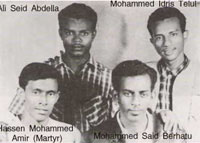
1968 Al Eqab' ( The Punishment Group that hijacked an Ethiopian aeroplane to Karachi)
The following members of Ikab hijacked the Ethiopian planes: Ali Said Abdella who destroyed an Ethiopian Airline Boeing 720 at Karachi Airport in 1969; Mohamed Osman Yusuf Saig and Mohamed Ali Omar Afarorah who hijacked, an Ethiopian passenger plane, a Boeing 707, in March 1969; Mohamed Saeed Salih Sengour etc., who hijacked an Ethiopian Airline plane in September 1969; Ali Mohamed Omer, Hamid Shateen; Mahmoud Suleiman who hijacked Ethiopian Airline plane, Boeing 720, in November 1969.
In 1969, Ethiopia Airlines not only became the target of ELF fighters but also of the Ethiopian student movement, protesting the killing of Telahun Guizaw, President of the USUAA, who was murdered by the security police in 1969. According to UNESCO publication (1994) shortly after the death of Telahun Guizaw, a group of seven Ethiopian university students succeeded in gaining control of an Ethiopian Airlines aircraft and forcing it to land in Khartoum from where they made their way to Algiers in August 1969. The group was led by Berhane Meskel with other five students.
The students were: 1. Amanuel Gebre Yesus; 2, Binyam Adane, a nephew of Ato Abebe Retta; 3. Iyasu Alemayehu; 4. Berhane Meskel Redda; 5 Abdissa Ayana; 6. Haileysus Weldesenbet. The students had forced an Ethiopian plane on a domestic flight to change course and land in Khartoum. The six students, along with an Ethiopian official, applied for political asylum in the Sudan. Amanuel Gebre Yesus who was anti-Haile Selassie leftist student said: “We forced the plane to Khartoum knowing that the communist authorities in Khartoum would not reject us. There was going to be a meeting in Khartoum where the Emperor was to join. So we had to go away and I went to Algeria. I was imprisoned there for 6 months and at last Herui Tedla came and freed me.”
In January 1971 the second Ethiopian plane were hijacked by Amanuel Yohannes, Yohannes Sebhatu, Musie Tesfamichael, and Debesai Gebre Selassie who all joined the EPLF. The hijackers forced the plane to fly from Bahr Dar to Khartoum then to Benghazi, Libya. The New York Time on 23 of January reported: “an Ethiopian airliner was hijacked today to Benghazi, Libya. It made refuelling stops in Kartoum, the Sudanese capital, and in Cairo. There were 23 persons aboard.The Sudanese radio reported that the hijackers were Eritrean students who had threatened to blow up the plane, a DC‐3, during its two‐hour stopover in Khartoum and had made the same threat in Cairo, where they asked for and received fuel and food
Adhanome G/Mariam (2005) in his interview said that after Amanuel joined the EPLF in 1971, he was sent on a mission to Addis Ababa from Gereger Sudan, where the EPLF’s base area was located. Furthermore Dr Aleme Eshete stated that Amanuel Yohannes an Eritrean secessionist and activist in Addis Ababa University who had joined ELF-PLF with Musse and Yohannes Sebhatu, after staying for a short time with the group in Sahel, had returned to Addis Ababa under the false name of Belay Tadesse (and Mohamed Osman Mohamed) and one or two false passports. The main purpose of Amanuel Yohannes being sent back to Addis Ababa by the EPLF was to offer hijack training to the Ethiopian revolutionaries who were his ex-comrades in the University. The aim of hijacking was to demonstrate their disapproval of the way Emperor Haile Selassie was governing the country; support the struggle of Eritreans against colonial rule and oppose world imperialism
To accomplish his task Amanuel flew to Addis Ababa from abroad disguised as a businessman. Petros Tesfagirgis (2001) states that Amanuel asked a comrade Mesfun Araya to go to Asmara, contact the EPLF and bring hand grenades and pistols for the hijacking. Mesfun took risks to bring arms for hijacking, flew to USA before the group met their death. Amanuel who had already one hijack experience succeeded in recruiting other hijackers for a new mission.
 |
|
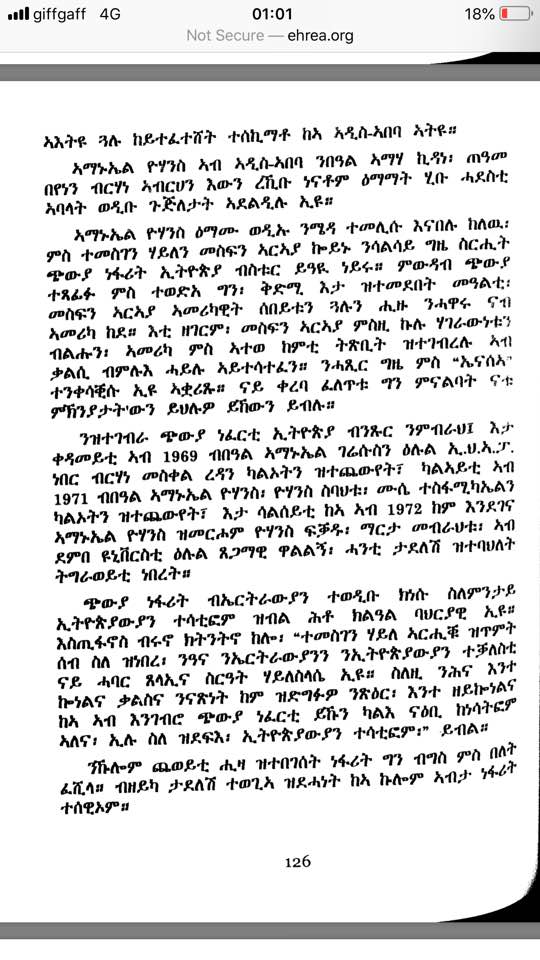 |
On 8 of December 1972 the Ethiopian airline were hijacked by Walelegn Mekonen, Getachew Habte, Tesfaye Birega, Tadelech Kidanemariam , Martha Mebrahtu, Yohannes Fekadu and Amanuel Yohannes. Shortly after the plane had taken off for Paris via Asmara, the hijacking attempted to seize the Ethiopian Airlines Boeing was foiled by Ethiopian security, that six hijackers were killed in an air battle.
On 09/12/1972 the New York Time reported that the hijackers were understood to be from the northern Ethiopian province of Eritrea, though an official statement by Ethiopian Airlines said the line had not determined where the seven had come from. A number of previous hijackings involving Ethiopian planes have been staged by members of the Eritrean Liberation Front, a guerrilla organization with left‐wing ties that seeks to separate the province from the nation.
Aleme Eshete also state that the hijackers were reportedly led by an Eritrean, a member of the EPLF, who had been a student at the Haile Selassie I University before he joined the EPLF. He sneaked into Ethiopia bearing a Somali passport disguised as a Somali. This drew suspicion and the Emperor's security was alerted. They followed him around and observed the people he was meeting. He was meeting revolutionary students and former students. It didn't take long for the security to find out that the young people were scheming an airplane hijack. They decided to use the occasion to "liquidate" them. So, they let them board the airplane alerting their anti-hijackers that the revolutionaries were armed and dangerous .
Many people were prompted to assume that the hijacking was the work of the ELF (Jebha) and/or PLF (later Shaebia/EPLF). Neither the ELF nor the PLF claimed responsibility for the hijacking.
The ELF could not claim the operation because they had nothing to do with it. So is the PLF as at that time Isaias did not support the rapprochement with the Ethiopian revolutionaries. Although the EPLF, then PLF, didn’t claim responsibility for the hijacking, Yohannes Sebhatu who was the director of publications and information in 1972 issued a statement which said:
“A heroic attempt to hijack an Ethiopian 720 Fan Jet bound for Paris was made by seven revolutionaries (two of whom were women) on December 8th. 1972. While six of them determinedly sacrificed their lives the remaining one ( Tadeletch Kidane Mariam) suffered bullet wounds while trying to execute her goal to the end and is now in enemy hands. The revolutionary heroes who took part in this internationalistic deed were: There is no room for reactionaries, opportunists and oppressors (under the cover of citizens). A progressive Eritrean is he who struggles and renders assistance to the oppressed peoples of the world and the progressive Ethiopian is he who believes in the independent existence of Eritrea, and in our struggle and who has internationalist duties”. To read the full statement, please see Appendix
As mentioned earlier, the operation had been organised by the EPLF fighter Amanuel Yohannes. He had asked Mesfun Araya to bring hand grenades and pistols from the EPLF for the hijacking which he did. Based on this fact and the statement, the EPLF was behind the hijacking operation of the 8th December 1972.
If the third group of the 8th December 1972 hijackers had succeeded they would have joined the EPLF as had the previous two groups of Ethiopian Airlines hijackers which had been led by Amanuel Yohannes and Berhane Meskel . The former group joined the EPLF after the 1971 hijacking and the latter group after hijacking a domestic Ethiopian plane to Algeria in 1969 got their training with the EPLF. Regarding this Aleme Eshete said if the hijackers had succeeded, it was reported that they were heading for Algeria to join Berhane-Meskel Redda and others who had hijacked another airplane about two years or so earlier: Furthermore, Petros Tesfagiorgis (2018) states that the hijackers were destined to go to Sahel for military training. They chose to leave Ethiopia by highjack the Airlines in order to get international publicity
However, the six hijackers were killed by the anti-hijacking security forces as soon as the plane took off on the 8th December 1972. Yohannes Fekadu was buried in Asmara attended by thousands of high school and Asmara university students. Martha was buried at the Petrose Paulos cemetery, in Addis Ababa, and many people came to her burial. A song was written in her memory to celebrate her and encourage others to follow her lead. It was always sung beyond the earshot of the Ethiopian authorities and the lyrics go like this:
Inquay do anes (let alone I)
Marta qua meyta ab seamy (even Martha perished in the sky)
source ehrea.org
When the hijacker names were read in the news, Amanuel name was not recognized because he had changed his name to a Muslim one, and no one claimed him. Consequently his remains were not only buried without a public funeral service but also no one knows where his grave is, and it took several months for his family to finally be told of his death.
In the history of the EPLF, Amanuel story was only briefly mentioned in the statement that was released by the EPLF after the operation when Yohannes Sebhatu was the director of publications and information in 1972. However, after Yohannes Sebhatu was arrested and executed, in 1975, the story of Amanuel Yohannes, who twice hijacked Ethiopian airlines, has never been told by the EPLF while that of other hijackers such as Ali Said Abdella has been repeatedly publicised.
Why is the EPLF silent on the heroic story of Amanuel Yohannes contributions to the Eritrea revolution? Adhanome G/Mariam in his interview answered this question.
According to him, Yohannes Sebhatu, Debesai Gebre Selassie and Musie Tesfamichael who hijacked the domestic plane with Amanuel Yohannes were executed under the pretext of their participation, for the reason that the EPLF didn’t want to honour Amanuel and his group for hjacking the Ethiopian airlines.
Here is what Adhnome said about Amanuel in his interview.
ተ/ጋ ኣድሓኖም:- “ኣብነት ክጠቕሰልካ: ኣማኑኤል የውሃንስ: ደበሳይ ገብረስላሰ: የውሃንስ ስብሃቱን ሙሴ ተስፋሚካኤልን ወላ ሓንቲ ታዕሊም ከይወሰዱ: ነፋሪት ኢትዮጵያ ጨውዮም ሊብያ ኣትዮም:: ብድሕሪኡ ክኣ ኣብ ህዝባዊ ሓይልታት ተሰሊፎም:: ኣማኑኤል የውሃንስ እንደገና ተመሳሳሊ ስርሒት ንኽፍጽም ተባሂሉ: ካብ ገረግር (ሱዳን) ኣዲስ ኣበባ ኣትዩ::
ኣማኑኤል ንዋለልኝን ማርታን….ወዘተ ዝርከብዎም ኢትዮጵያውያንን ኤርትራውያንን ሒዙ: ካብ ኣዲስ ኣበባ ነፋሪት ክጨውዩ ምስ ፈተኑ ብጸጥታ ኢትዮጵያ ተፈሊጦም ኣብታ ነፋሪት ተቐቲሎም:: እዚ ታሪኽ’ዚ ኢትዮጵያውያን ብተደጋጋሚ የልዕልዎ ኢዮም:: እዚ ድማ: ንጅግንነት ዋልልኝን ማርታን ንክዝክሩ ኢዩ:: ብኣንጻሩ ታሪኽ ኣማኑኤል የውሃንስ ብህ.ግ.ሓ.ኤ ክዝከር ወይ ክልዓል ሰሚዕካ ትፋልጥ? ነቶም ታሪኹን ተወፋይነቱን እንፈልጥ የዕርኹቱ ኸ ዝኣምንሉ ምርስዑ ናይ ሕልና ቅሳነት ይህበና ዶ ይመስለካ? ደበሳይ ገብረስላሰ: የውሃንስ ስብሃቱን ሙሴ ተስፋሚካኤልን ድማ: ብሰበብ ምንቅስቓስ ናይ 1973 ብዓሊ ሰይድን ጉጅልኡን ተቐቲሎም:: ምጭዋይ ነፋሪት ጅግንነት ዘብል እንተኾይኑ: እዚኦም’ሲ ጨውዮም እንዲዮም ድኣ:: ይኹን’ምበር ኣሽንኳይ’ዶ ከም ጀጋኑ ክጥቀሱን ክቑጸሩን: ስድራ ቤቶም’ውን መስዋእቶም ከይንገሩ ተሓሪሞም ኢዮም::
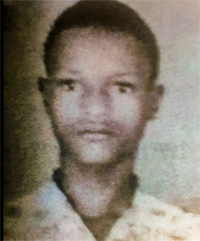

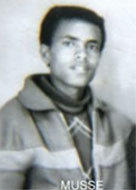

Yohannes, Amanuel, Musie and Debesai
Amanuel and his comrades should be remembered by the present and future younger generations for the significant role they played in the struggle for independence in the 1970s.
Eternal glory for the Martyrs
Appendix
(This statement was released by the EPLF after the operation when Yohannes Sebhatu was the director of publications and information in 1972. After Yohannes Sebhatu was arrested and executed, in 1975, the story of Amanuel Yohannes has never been told by the EPLF while that of other hijackers such as Ali Said Abdella has been repeatedly publicised).
ERITREAN POPULAR LIBERATION FORCES
PUBLISHED IN FIELD BY THE E.P.L.F.
(Sketch of a fighter holding weapon on one arm and the UN flag on the other, pinning a mouse/person under, and written – HAILE THE VAMPIRE
A New Chapter In Revolutionary Struggle
A heroic attempt to hijack an Ethiopian 720 Fan Jet bound for Paris was made by seven revolutionaries (two of whom were women) on December 8th. 1972. While six of them determinedly sacrificed their lives the remaining one ( Tadeletch Kidane Mariam) suffered bullet wounds while trying to execute her goal to the end and is now in enemy hands. The revolutionary heroes who took part in this internationalistic deed were:
1. Amanuel Yohannes. During the time when he was a student in the University in-Addis Abeba he took his place in the ranks of the student union, by fighting in an internationalist spirit against oppression with many anti-enemy acts to his credit. In addition, with three of his heroic comrades, he hijacked a plane from Bahr Dar to Benghazi (Libya) in January 1971; He was a conscious and mature fighter of the People’s Forces, who later on, took part in the many sacrifices of his comrades in his country battlefield.
2. Wallelign Mekonnen was twice imprisoned by the enemy (1969 and 1970). His first spell in prison ended by his being released due to his student comrades’ support; his second, due to the consequences of his comrades’ strength of purpose and the fear it caused in the progressive Ethiopian Students’ Movement; he was a hero who, in the spirit of internationalism, worked to acquaint with and instill faith in the just cause of Eritrea among his comrades and people.
3. Marta Mebrahtu was a seventh year Medical student in the University in Addis Abeba, who in popular assemblies won wide acclaim as a conscious and mature and determined revolutionary. Marta’s greatest desire was to serve the people and fighters in the sphere of medicine
4. Getachew Habte. A fighter of long standing and one of the founders of the Ethiopian Students’ Movement, he was working with undimmed revolutionary ardour after cutting short his studies in the university, to set up and consolidate a revolutionary force.
5.Yohannes Fekadu, a fourth year University student and persevering Eritrean was, previously, while still very young , condemned to live away from his family and his country in exile.
6.Tadeletch Kidane Mariam was an employee of an advertising agency, and a determined progressive who, in collaboration with her comrades, worked for the overthrow of the Feudal-Imperialist Ethiopian Government, and
7.Tesfaye Berega. Formerly a teacher in the Medhane Alem School, he was unjustly expelled from his job because he expressed his hatred for the rotten Haile Selassie regime to the youth of his country, taught in a private school, and worked in the spirit of self-sacrifice to realise his aims to the end.
Ammanuel Yohannes, Marta and Yohannes Fekadu were Eritreans while Wallelign, Tadeletch, Getachew and Tesfaye were Ethiopians. This deed which was done by the sons and daughters of the two neighbouring countries explifies the struggle of Eritreans against foreign, colonial rule and for our independence, and the struggle of Ethiopians to destroy Feudalism, in essence, it was done in an internationalist spirit to oppose world imperialism: an unforgettable day and an indelible page in history. These martyrs’ performance of their national duties for the salvation of the people, for the benefit of oppressed people, rejecting, linguistic, cultural and religious differences. (and some apparent revolutionaries’ sentiment of chauvinism) was a pioneering act for us. Its basis lies in a revolutionary duty linked by mutual benefit and standing upon an alliance sealed with blood. They stood for a great aim; the price to be paid, had by necessity to be great and dear. The liberation of oppressed people is the sacred desire of genuine revolutionaries, and the price to be for it is one’s life, that highest and most valuable sacrifice a human being can offer.
It is for this reason that we do not regard the deaths of these beloved comrades as a sad fate but as an inspiring example because many people have learned by their blood that was spilt; and those (especially women) who have pondered over the circumstances are not few. We should regard the performance of Yohannes Fekadus' funeral ceremony in Asmara a as an example. There is absolutely no greater testimony of victory. It was with this as the basis that Ammanuel’s daily motto was: “either I shall dismantle Haile Selassie’s regime or I shall die on the way”.
By climbing onto the stage of struggle with a high degree of political consciousness to oppose the fascists’ atrocities Marta and Tadeletch have earned the right of not only being in the vanguard of the women of the two countries, Eritrea and Ethiopia, and their rightful place in the ranks of revolutionaries, but also that of instilling courage in people and making them determined as well.
The recent attempt and the sacrifice of lives has raised the standard of the form of struggle one step higher and has become ample witness to the fact that our struggle does not discriminate upon the basis of sex, age, nationality or religious belief and has a lofty internationalist line, work and duty as well.
The heroic deed performed is not one isolated blow upon the enemies of the people of the world (American Imperialism and Ethiopian Feudalism); it is one link in the long chain of our struggle and revolutionary development. The word of the sacrificed six comrades and Tadeletch Kidane Mariam who is suffering enchained by the enemy is a great herald of the salvation and solidarity of the progressive peoples of the world (especially the peoples of Eritrea and Ethiopia) in their struggle for an assured people’s and revolutionary victory.
There is no room for reactionaries, opportunists and oppressors (under the cover of citizens). A progressive Eritrean is he who struggles and renders assistance to the oppressed peoples of the world and the progressive Ethiopian is he who believes in the independent existence of Eritrea, and in our struggle and who has internationalist duties.
Because they are pure revolutionaries who know that they are mortals and yet work like immortals, their lives ate short are due to love of the people and hatred of oppression.
Their reward lies in the fruit of their work and in their immortality.
Victory for the Eritrean Revolution.
Victory for the Ethiopian Revolution.
Eternal glory for the Martyrs
(Beneath is a circle seal with initials E.P.L.F.C)
ehrea.org © 2004-2017. Contact: rkidane@talk21.com | ||||